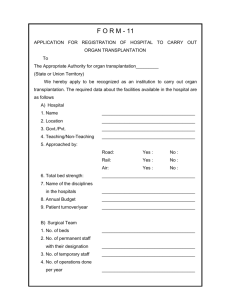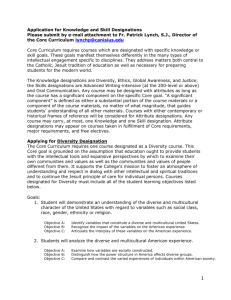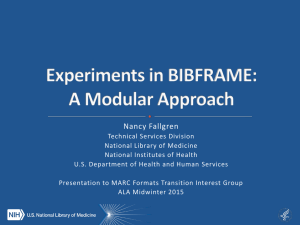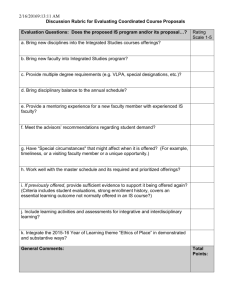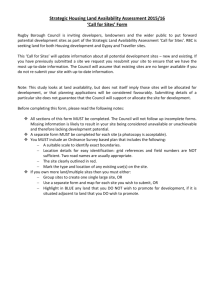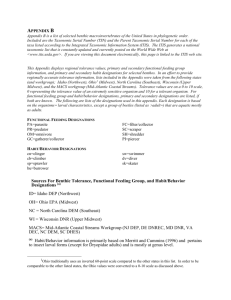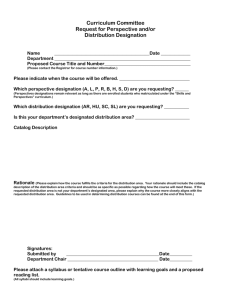Complex relationships
advertisement
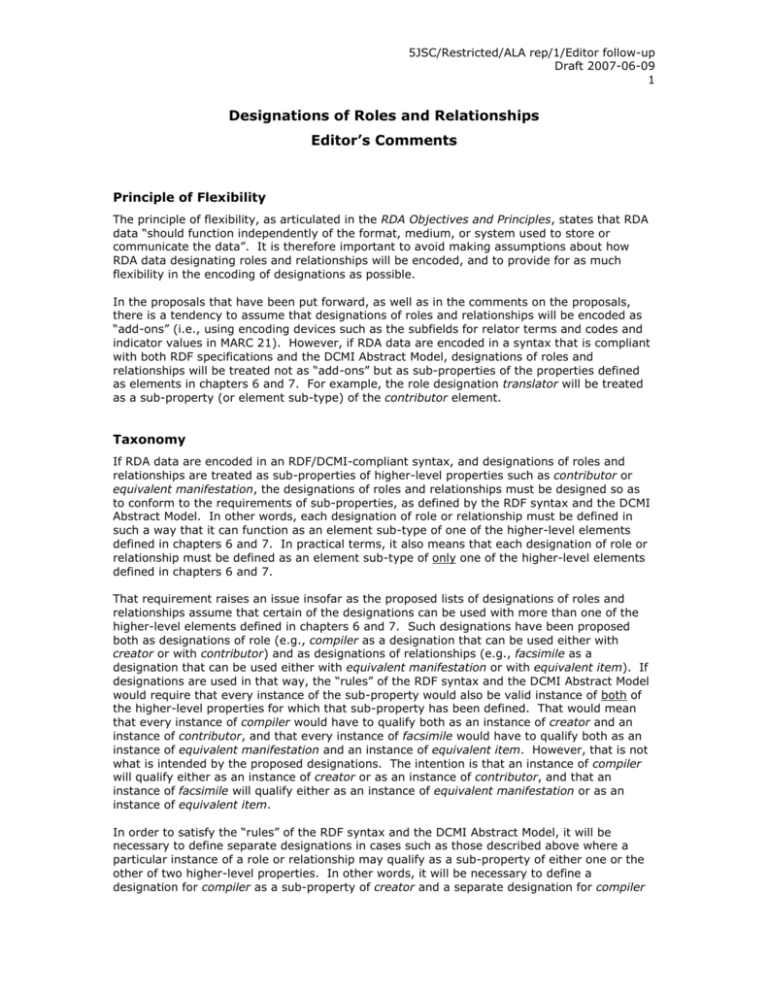
5JSC/Restricted/ALA rep/1/Editor follow-up Draft 2007-06-09 1 Designations of Roles and Relationships Editor’s Comments Principle of Flexibility The principle of flexibility, as articulated in the RDA Objectives and Principles, states that RDA data “should function independently of the format, medium, or system used to store or communicate the data”. It is therefore important to avoid making assumptions about how RDA data designating roles and relationships will be encoded, and to provide for as much flexibility in the encoding of designations as possible. In the proposals that have been put forward, as well as in the comments on the proposals, there is a tendency to assume that designations of roles and relationships will be encoded as “add-ons” (i.e., using encoding devices such as the subfields for relator terms and codes and indicator values in MARC 21). However, if RDA data are encoded in a syntax that is compliant with both RDF specifications and the DCMI Abstract Model, designations of roles and relationships will be treated not as “add-ons” but as sub-properties of the properties defined as elements in chapters 6 and 7. For example, the role designation translator will be treated as a sub-property (or element sub-type) of the contributor element. Taxonomy If RDA data are encoded in an RDF/DCMI-compliant syntax, and designations of roles and relationships are treated as sub-properties of higher-level properties such as contributor or equivalent manifestation, the designations of roles and relationships must be designed so as to conform to the requirements of sub-properties, as defined by the RDF syntax and the DCMI Abstract Model. In other words, each designation of role or relationship must be defined in such a way that it can function as an element sub-type of one of the higher-level elements defined in chapters 6 and 7. In practical terms, it also means that each designation of role or relationship must be defined as an element sub-type of only one of the higher-level elements defined in chapters 6 and 7. That requirement raises an issue insofar as the proposed lists of designations of roles and relationships assume that certain of the designations can be used with more than one of the higher-level elements defined in chapters 6 and 7. Such designations have been proposed both as designations of role (e.g., compiler as a designation that can be used either with creator or with contributor) and as designations of relationships (e.g., facsimile as a designation that can be used either with equivalent manifestation or with equivalent item). If designations are used in that way, the “rules” of the RDF syntax and the DCMI Abstract Model would require that every instance of the sub-property would also be valid instance of both of the higher-level properties for which that sub-property has been defined. That would mean that every instance of compiler would have to qualify both as an instance of creator and an instance of contributor, and that every instance of facsimile would have to qualify both as an instance of equivalent manifestation and an instance of equivalent item. However, that is not what is intended by the proposed designations. The intention is that an instance of compiler will qualify either as an instance of creator or as an instance of contributor, and that an instance of facsimile will qualify either as an instance of equivalent manifestation or as an instance of equivalent item. In order to satisfy the “rules” of the RDF syntax and the DCMI Abstract Model, it will be necessary to define separate designations in cases such as those described above where a particular instance of a role or relationship may qualify as a sub-property of either one or the other of two higher-level properties. In other words, it will be necessary to define a designation for compiler as a sub-property of creator and a separate designation for compiler 5JSC/Restricted/ALA rep/1/Editor follow-up Draft 2007-06-09 2 as a sub-property of contributor, and to define a designation for facsimile as a sub-property of equivalent manifestation and a separate designation for facsimile as a sub-property of equivalent item. Redundancy The proposed designations of roles and relationships include a number of designations that operate at the same level as the elements defined in chapters 6 and 7 (e.g., creator, contributor, accompanies, describes). From an encoding perspective, those designations are redundant. That is to say that those roles and relationships are already covered by the elements that are defined in chapters 6 and 7. Regardless of whether the RDA data are encoded in an RDF/DCMI-compliant syntax, in a MARC 21 syntax, or in some other syntax, it is assumed that the role or relationship at that level will be identified explicitly as part of the encoding syntax, and there would be no need for a designation of role that simply repeats what has already been identified through the identification of the element. A question has been raised as to whether designations of role need to be defined for the various roles associated with legal proceedings. If it is determined that such roles should be differentiated, consideration should be given to defining separate elements for those roles and others associated with legal and religious works (as listed in the RDA Element Analysis table) as an alternative to differentiating them through designations of role. From the perspective of an RDF/DCMI-compliant syntax, that would effectively mean treating those roles as properties at the top level of the hierarchy rather than treating them as sub-properties. Levels of hierarchy The proposed designations of roles and relationships generally reflect either two or three levels of hierarchy. In some cases, the designation of role or relationship functions as a subproperty (or element sub-type) of the property that is defined as an element in chapter 6 or 7 (e.g., translator as a sub-property of contributor, or revision of as a sub-property of source work (or expression)). In other cases, the designation of role or relationship functions as a sub-property of a designation of role or relationship that is defined as a sub-property of an element defined in chapter 6 or 7, making it a sub-sub-property of that element (e.g., dancer as a sub-property of performer, which in turn is a sub-property of contributor, or facsimile as a sub-property of reproduction, which in turn is a sub-property of equivalent manifestation). In order to support the treatment of RDA designations of roles and relationships as subproperties and sub-sub-properties of elements defined in chapters 6 and 7 when they are encoded in an RDF/DCMI-compliant syntax, it will be essential to make those hierarchical relationships explicit in the taxonomy of the designations. It should also be noted that extending the taxonomy of RDA designations of roles and relationships to include additional levels of hierarchy would not be problematic, as long as the structure of the taxonomy observes the RDF/DCMI sub-property “rules”. Faceting It has been suggested that a faceted approach might be used to make the list of designations of roles extensible (for example, by allowing terms such as “dubious”, “erroneous”, “former”, or “current” to be combined with various terms in the list, as applicable. While that approach may seem to have some advantages in terms of reducing the number of designations listed, it has been noted in comments on the proposal that it could be problematic with respect to providing a controlled vocabulary for RDA designations of roles that is comprehensive in the sense of enumerating all valid terms. 5JSC/Restricted/ALA rep/1/Editor follow-up Draft 2007-06-09 3 Using facets of that type would also add another level of complexity when encoding RDA data in an RDF/DCMI-compliant syntax. Effectively, another node in the RDF graph would be required in order to link the designation of role with the value for the added facet. Granularity It has been suggested that a faceted approach might also be used to allow the combining of a designation of role with a term for the specific part or aspect of a resource, in order to construct designations similar to those in the MARC 21 list for “author of introduction”, etc. But again, that approach could be problematic with respect to providing a controlled vocabulary that is comprehensive, as well as adding another level of complexity when encoding RDA data in an RDF/DCMI-compliant syntax. As has been noted in comments on the proposal, it might be more effective to handle that level of specificity by creating a separate description for the part and using a higher-level designation of role (e.g., author) in conjunction with an access point associated with that specific part. Complex relationships When encoding RDA data in an RDF/DCMI-compliant syntax, all n-ary relationships (i.e., all relationships involving more than two entities) are encoded as a linked set of binary relationships. Encoding complex relationships will also facilitate the automatic generation of reciprocal relationships. For example, if the merger of two resources (A and B) to produce a third new resource (C) is recorded as A merged with B, A merged to form C, and B merged to form C, it is possible to automatically generate the reciprocals B merged with A, C formed from merger of A, and C formed from merger of B. While the encoding of a complex relationship as a set of binary relationships will facilitate machine processing of the data (e.g., generating reciprocal links), RDA also provides for recording complex relationships in the form of an unstructured description that can be used to display the relationship information in a natural language form (e.g., “A merged with B to form C”). To facilitate both machine processing and the display of relationship information in a natural language form, a complex relationship can be recorded using both conventions. MARC 21 relator codes It has been suggested that the MARC 21 list of relator codes might be used as an alternative list of values for designating roles. However, as noted above in the section on levels of hierarchy, it will be essential to make the hierarchical relationships between designations of roles and relationships explicit in order to support the treatment of those designations as subproperties and sub-sub-properties of elements defined in chapters 6 and 7 when they are encoded in an RDF/DCMI-compliant syntax. Because the hierarchical relationships between codes in the MARC 21 list of relator codes are not made explicit, using the MARC 21 list of values as an alternative to the RDA designations would introduce an added level of complexity when exporting RDA data in an RDF/DCMI-compliant syntax. In order to do so, roles coded using values from the MARC 21 list would first have to be mapped back to the corresponding RDA designations, so that the hierarchical relationships could be reinstated. Given the current lack of semantic integrity in the MARC 21 list, that mapping could prove to be problematic in a number of instances. Definitions If the intent is to develop a DC-RDA application profile, with vocabulary encoding schemes for all RDA-defined controlled vocabularies, it will be necessary to define the terms used in those vocabularies. In that context, definitions will be required for all terms used in the RDA 5JSC/Restricted/ALA rep/1/Editor follow-up Draft 2007-06-09 4 controlled vocabularies for designations of roles and relationships. Applying the principles established for the RDA glossary (i.e., defining only terms that are not used in the ordinary dictionary meaning) to terms used in RDA controlled vocabularies would not be appropriate.
